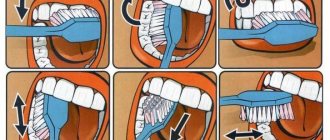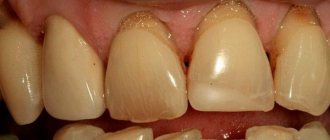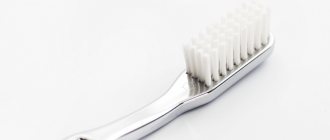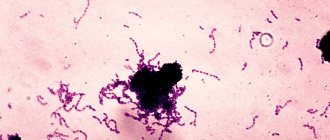Tartar formation and complications of this condition are one of the most common reasons for visiting a dentist. But not everyone knows that the appearance of this unaesthetic plaque can be prevented, and that prolonged absence of treatment for already formed stone can lead to tooth loss.
Experts diagnose almost all people with tartar, the treatment of which, as a rule, is quite expensive. To understand how you can avoid this problem, you need to understand what tartar is and how you can prevent its occurrence.
What is tartar
Tartar is hardened soft plaque. When brushing teeth incorrectly or poorly, a soft mass consisting of fragments of the mucosal epithelium, food particles and colonies of bacteria accumulates on their surface and in the interdental spaces. Under the influence of saliva and substances produced by bacteria, the mass gradually hardens, turning into tartar. Hard deposits may be observed on the back surfaces of teeth and between teeth, in which case they are classified as supragingival calculus. Gradually, under the influence of gravity and chewing movements, the stones move under the mucous membrane of the gums and are classified as subgingival.
In what cases does stone plaque form?
The reason for the formation of tartar is poor quality dental care, in which soft plaque is not completely removed. High mineral content causes plaque to harden. Using a too soft toothbrush, lack of attention to the interdental spaces and gum margins, irregular oral hygiene, etc. are the main sources of the problem.
But there are factors that increase the likelihood of hard deposits forming on teeth:
- diseases of the digestive system and endocrine system, in which the chemical composition of saliva changes;
- malocclusions and dental defects that form particularly difficult areas to clean;
- wearing dentures, braces, brackets, plates and other structures that make it difficult to properly clean teeth using a traditional brush and paste;
- a large amount of carbohydrate foods in the diet, which facilitates the gluing of soft plaque particles.
Laser teeth cleaning
The non-contact procedure involves exposure of the laser beam directly to the stone, that is, bypassing the gums. Thus, with the help of a laser, the stone is crushed into small particles, which are subsequently removed using a jet of water. As part of this hygiene procedure, the oral cavity is protected with a lining to prevent damage to soft tissue.
The average duration of laser removal of stone and hard plaque from teeth is up to 45 minutes. The technique is painless, the result is visible immediately after the procedure.
Contraindications for laser teeth cleaning:
- acute form of periodontitis;
- young age (the procedure is not performed on minors);
- pregnancy;
- viral and infectious diseases;
- presence of braces in the cavity;
- the presence of veneers and lumineers;
- too many filled teeth (laser can have a negative effect on fillings);
- the presence of diseases of the heart, blood vessels, and respiratory system.
Kinds
Plaque is divided into two categories. First, supragingival stone appears, the cause of which is poor oral hygiene. Such deposits are located above the upper edge of the gingival crest, so they are easily diagnosed during a routine examination.
The characteristic features of supragingival tartar include:
- Localization on the inner surface of the tooth, from the side of the tongue;
- White or yellowish tint;
- The consistency is hard or clay-like.
The plaque is unstable, so it can be removed mechanically without any problems.
Subgingival calculus appears as a result of the fact that supragingival plaque descends down the root of the tooth and mineralizes. It forms in the gum pocket and is diagnosed only when using special dental instruments. Such deposits are considered age-related and most often appear in people over 40 years of age. If personal hygiene rules are not followed, it can appear at any age.
Signs of tartar:
- Dense and hard consistency;
- Light brown or greenish-black tint;
- Swelling and bleeding gums.
Removing tartar in the dentist's office
The doctor must decide whether to remove tartar and which method is best for you - he, like no one else, sees the whole picture of your oral cavity and can adequately assess the current situation.
In dentistry, tartar is removed using ultrasound. Powerful ultrasonic waves easily crush the many crystals that make up the stone, and the remains are removed from the tooth enamel with special dental instruments. If you regularly come for this procedure, and also do not neglect comprehensive oral hygiene, you can completely get rid of formations for many years.
Symptoms of Tartar
The first symptoms of tartar are a change in the color of the enamel on the upper molars and lower incisors. Soft yellow or gray plaques appear. First of all, tartar forms in areas where there is no self-cleaning of the surface during the process of chewing food or rinsing: the interdental space, the inner walls of the tooth.
Primary symptoms:
- Bad breath;
- Mild itching of the gums;
- Slight bleeding.
If no measures are taken to remove plaque, it begins to mineralize, becoming harder. As a result, the gums may become inflamed and there will be severe swelling and redness. Detachment of the gingival margin is possible, which leads to the appearance of a periodontal canal.
What are the dangers of tartar?
In cases where tartar has already formed, treatment should be carried out immediately. Otherwise, it moves under the gums and leads to severe disorders of tissue metabolism in soft tissues.
As a result, acute or chronic gingivitis develops, the ligamentous apparatus of the tooth becomes inflamed and, as the most severe complication, periodontal disease develops - atrophy of the tissues that provide support to the tooth. As a result, a person who has developed subgingival tartar in the future faces the need to remove teeth that have lost stability and are no longer able to perform their functions.
Methods for treating tartar
Treating tartar on your own at home is not possible. Tartar removal is performed using practical and painless methods in the dentist’s office:
- Ultrasonic cleaning. This is the treatment of tartar with a scaler. The equipment generates low-frequency ultrasonic vibrations that destroy dental plaque. After this, the dentition is washed with a stream of water, and the enamel is ground and polished.
- Air Flow whitening system. In this case, cleaning is performed with an abrasive compound supplied under pressure through a special nozzle. The composition includes air, water and sodium carbonate. The equipment does an excellent job of cleaning the interdental space and effectively removes stubborn plaque.
- Laser cleaning. This is a non-contact technique that does not cause discomfort or pain. Tartar cleaning is performed with a directed laser beam, the remaining particles are washed out of the oral cavity with a water-air jet.
How to remove tartar on your own?
Removing small stones yourself is possible, but you will need to soften them and then take a long time and painstakingly brush them off with a toothbrush. So, use the following methods:
- Boil the walnut peel in water, then immerse a toothbrush with stiff bristles in the broth. After a while, apply toothpaste with an abrasive effect to the brush and rub the stones for a while, then rinse your mouth with water.
- A mixture of radish and lemon is also very effective - it softens tartar well. Mix grated radish with lemon pulp, chew and spit out, and then rinse your mouth.
- You can remove stones from your teeth using a mixture of alum, turmeric and ginger with sea salt.
- Tea tree oil is good for removing stone at home - add it to toothpaste and brush your teeth. This mixture removes plaque perfectly!
- You can remove stones from your teeth using natural honey dissolved in ordinary boiled water. This method is good for small deposits.
- Using regular table salt also helps a lot. Simply soak a soft toothbrush in water and dip it in salt, then gently massage your gums and brush your teeth.
Such treatment lasts more than one month, and the procedures must be daily.
How does an irrigator help with tartar?
One of the most frequently asked questions about whether an irrigator removes tartar can be answered this way: the irrigator helps with the prevention of tartar. It can only help if deposits have just begun to form and they have not yet formed stone. Regular and thorough brushing with a toothbrush and toothpaste, flossing, and completing your oral care with a irrigator can greatly reduce the risk of tartar.
But even in this case, tartar cleaning should be completed in the dentist’s office: the doctor will grind the enamel to eliminate roughness that facilitates the formation of plaque.
What to do to avoid the formation of tartar on your teeth
Take preventive measures:
- do not forget to brush your teeth thoroughly in the morning and evening
- purchase quality household hygiene products
- Don’t limit yourself to just one toothbrush: use flosses, irrigators, rinses
- avoid frequent snacking, balance your diet
- after eating, rinse your mouth with water
- less soft, high-calorie food, more solid and healthy food
- watch your health
- Visit your dentist and hygienist regularly
These simple tips will allow you to eliminate the first signs of dental plaque in time and reduce the risks of developing caries and periodontitis, which will be more difficult and expensive to treat.
Come to the Center for Modern Dentistry. Our specialists will teach you home hygiene techniques, tell you which brush and paste you need to use, and completely remove stubborn plaque in an effective and affordable way without harm to your health.
Prevention of tartar formation
The only reliable and effective means of prevention is control over the quality and regularity of dental and gum care.
Be sure to brush your teeth at least 2 times a day (morning and evening), ending each procedure with the use of an irrigator. This will help remove soft plaque from areas that traditional oral hygiene products cannot reach.
In addition, it is important to monitor your overall health, promptly seek bite correction and minimize the consumption of fast carbohydrates such as baked goods, sweets, etc.
More detailed information is presented in the catalog of oral irrigators.
Causes of plaque and tartar
The main reason for the appearance of plaque and tartar is associated with the accumulation of pathogenic microflora in the oral cavity. In general, this is a normal process, but deposits must be removed independently and several times a day. If this is not done, their number will increase significantly, which will lead to various complications - diseases of the teeth and gums.
In addition to poor hygiene, there may also be other factors that cause increased plaque formation on teeth. These include:
- smoking and drinking alcohol,
- unhealthy diet - eating a large amount of carbonated drinks and sweets, focusing on soft foods and avoiding hard foods, which have a cleansing effect on the enamel (especially a diet without vegetables and fruits),
- taking certain antibiotics and medications that disrupt the composition and quantity of saliva,
- diabetes mellitus, hormonal disorders.











